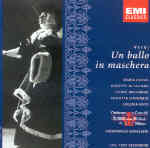Like others in EMI’s recent issues of complete opera recordings featuring Maria Callas, this December 1957 Un Ballo has long been available on numerous LP and CD labels. And like the others I’ve heard, EMI’s refurbished transfer is superior in tonal integrity and in vivid, present sound, though with occasional patches of distortion and imbalances typical of live stage recordings. The only real question for Callas fans is whether they need another Callas Un Ballo, since they probably have her EMI studio recording with di Stefano, Gobbi, and Barbieri recorded a year earlier under Antonio Votto’s routine direction. The short answer is: Yes. Callas’ Amelia is more effective here, more vital and spontaneous than in the studio. On the La Scala stage, she’s working in a more conducive environment–not only the “live” versus studio situation, but also with a cast and conductor better matched to her extraordinary talents. Vocally, she’s not at her smoothest, and some sustained high notes have a slight hint of wobbles to come. But such shortcomings are minor–insignificant alongside the electricity she generates.
The Riccardo is Giuseppe di Stefano, here singing with more passion and fire than on Callas’ studio Un Ballo. Ettore Bastianini’s Renato is ideal, his rich baritone filling in Verdi’s lines with a vocal plushness and evenness throughout its range. He was often criticized for not matching his ample voice with commensurate subtlety and elegance, but here he’s vocally superior to Tito Gobbi on Callas’ studio set, and he yields nothing in interpretive subtlety to his rival. Among the many highlights is the way Bastianini and Callas play off each other in Act 3, which includes an “Eri tu” that can’t fail to move the hardest heart. Giulietta Simionato, reigning Queen of Italian mezzos in the 1950s, is equally superb as Ulrica, her fresh, wide-ranging voice and dramatic power an improvement over the veteran Fedora Barbieri in EMI’s studio set.
The critical difference between this recording and the studio one is Gavazzeni’s conducting, full of vivid colors and sharp accents that bring the drama to life. Every opera collection needs a Callas Un Ballo and this one is her finest. Others on this high level must include the 1940 Met version with Milanov and Björling and the 1943 Serafin with Caniglia and Gigli. If you want a stereo supplement to those, the EMI Muti offers good singing and high-voltage conducting.
































